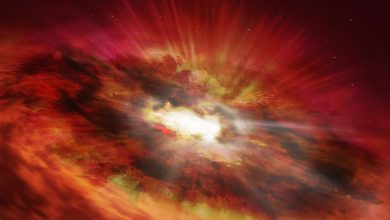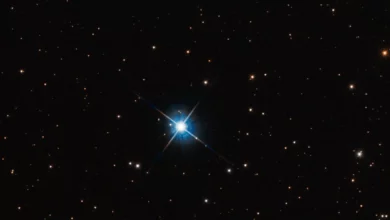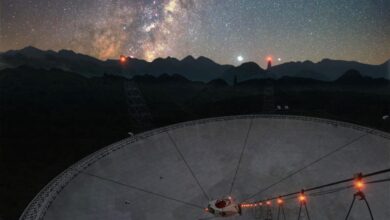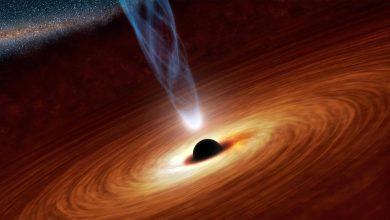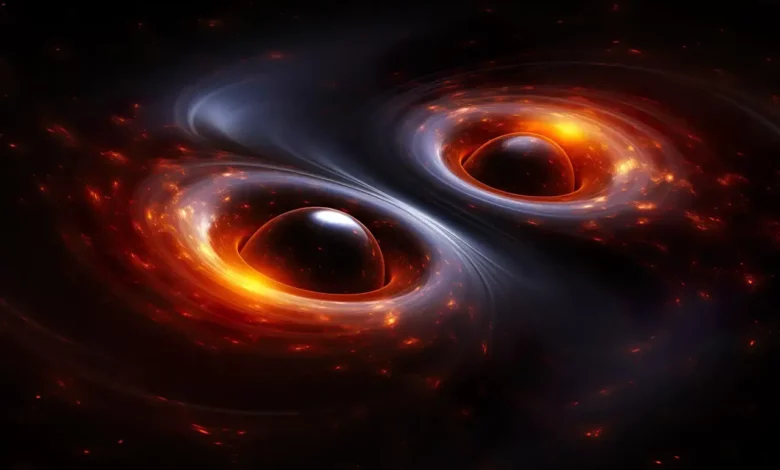
Lead Image: Following 15 years of observing pulsars, the NANOGrav collaboration has detected gravitational waves stronger than ever before, likely produced by supermassive black hole pairs. This groundbreaking discovery presents the first evidence for the gravitational wave background, which is surprisingly louder than anticipated, possibly pointing to an abundance of supermassive black holes or alternative gravitational wave sources.
After 15 years of carefully observing stars called pulsars throughout our galaxy, the NANOGrav collaboration has “heard” the perpetual chorus of gravitational waves rippling through our universe.
Following 15 years of data collection in a galaxy-sized experiment, scientists have “heard” the perpetual chorus of gravitational waves rippling through our universe for the first time — and it’s louder than expected.
The groundbreaking discovery was made by scientists with the North American Nanohertz Observatory for Gravitational Waves (NANOGrav) who closely observed stars called pulsars that act as celestial metronomes. The newly detected gravitational waves — ripples in the fabric of space-time — are by far the most powerful ever measured: They carry roughly a million times as much energy as the one-off bursts of gravitational waves from black hole and neutron star mergers detected by experiments such as LIGO and Virgo.
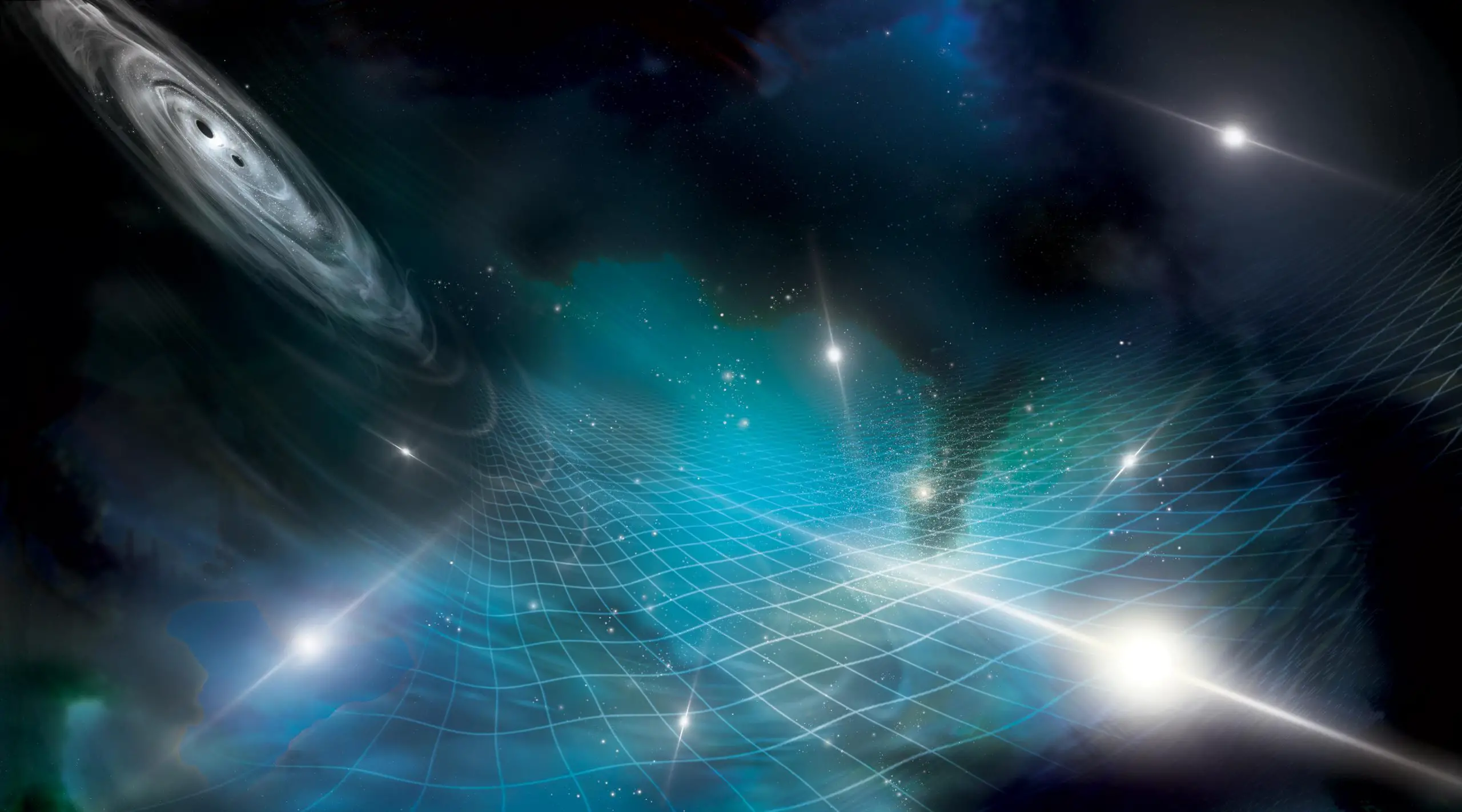
Most of the gigantean gravitational waves are probably produced by pairs of supermassive black holes spiraling toward cataclysmic collisions throughout the cosmos, the NANOGrav scientists report in a series of new papers published today (June 29) in The Astrophysical Journal Letters.
“It’s like a choir, with all these supermassive black hole pairs chiming in at different frequencies,” says NANOGrav scientist Chiara Mingarelli, who worked on the new findings while an associate research scientist at the Flatiron Institute’s Center for Computational Astrophysics (CCA) in New York City. “This is the first-ever evidence for the gravitational wave background. We’ve opened a new window of observation on the universe.”
The existence and composition of the gravitational wave background — long theorized but never before heard — presents a treasure trove of new insights into long-standing questions, from the fate of supermassive black hole pairs to the frequency of galaxy mergers.
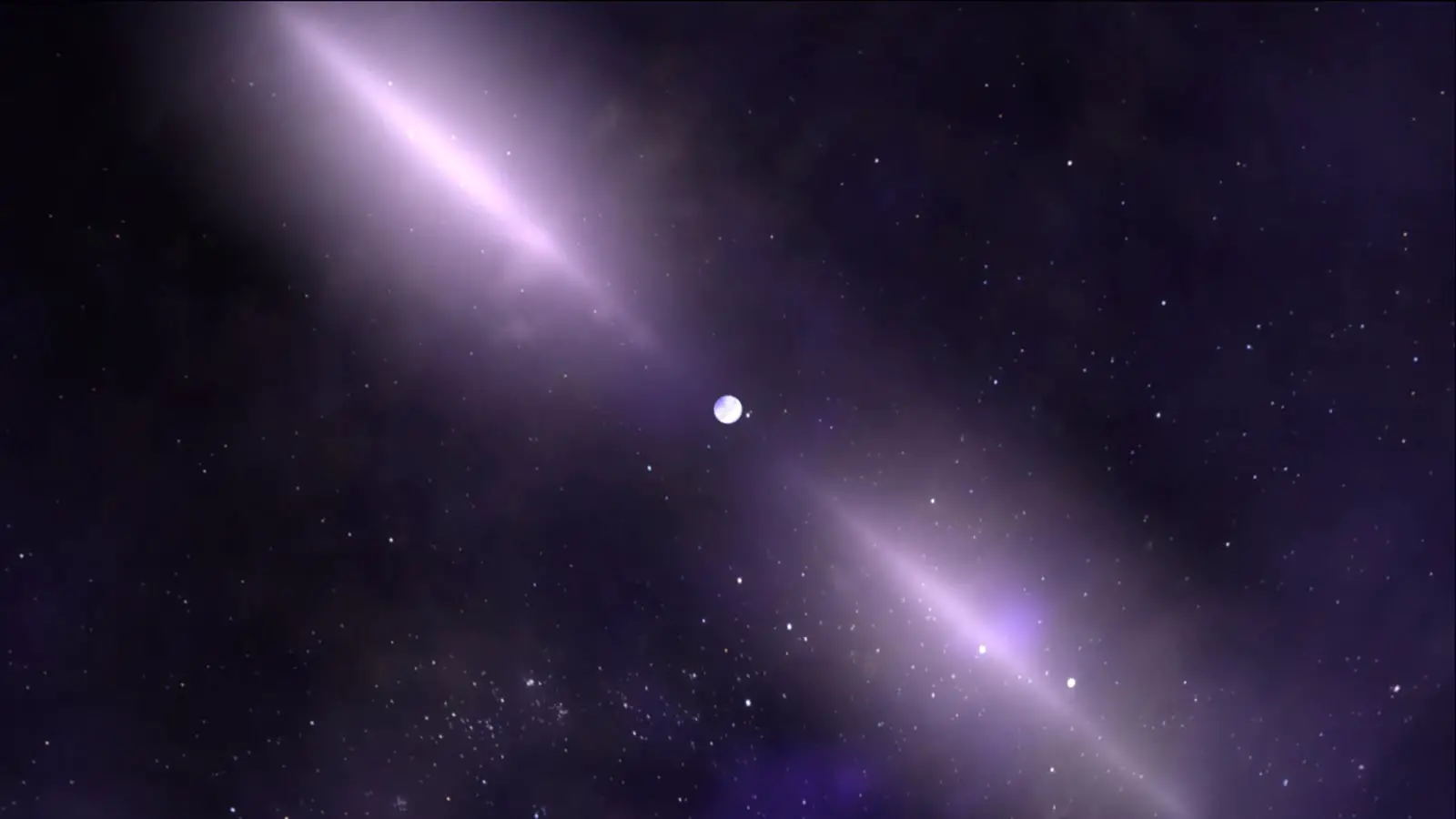
For now, NANOGrav can only measure the overall gravitational wave background rather than radiation from the individual “singers.” But even that brought surprises.
“The gravitational wave background is about twice as loud as what I expected,” says Mingarelli, now an assistant professor at Yale University. “It’s really at the upper end of what our models can create from just supermassive black holes.” The deafening volume may result from experimental limitations or heavier and more abundant supermassive black holes. But there’s also the possibility that something else is generating powerful gravitational waves, Mingarelli says, such as mechanisms predicted by string theory or alternative explanations of the universe’s birth. “What’s next is everything,” she says. “This is just the beginning.”
A Galaxy-Wide Experiment
Getting to this point was a years-long challenge for the NANOGrav team. The gravitational waves they hunted are different from anything previously measured. Unlike the high-frequency waves detected by earthbound instruments such as LIGO and Virgo, the gravitational wave background is made up of ultra-low-frequency waves. A single rise and fall of one of the waves could take years or even decades to pass by. Since gravitational waves travel at the speed of light, a single wavelength could be tens of light-years long.
No experiment on Earth could ever detect such colossal waves, so the NANOGrav team instead looked to the stars. They closely observed pulsars, the ultra-dense remnants of massive stars that went supernova. Pulsars act like stellar lighthouses, shooting beams of radio waves from their magnetic poles. As the pulsars rapidly spin (sometimes hundreds of times a second), those beams sweep across the sky, appearing from our vantage point on Earth as rhythmic pulses of radio waves.
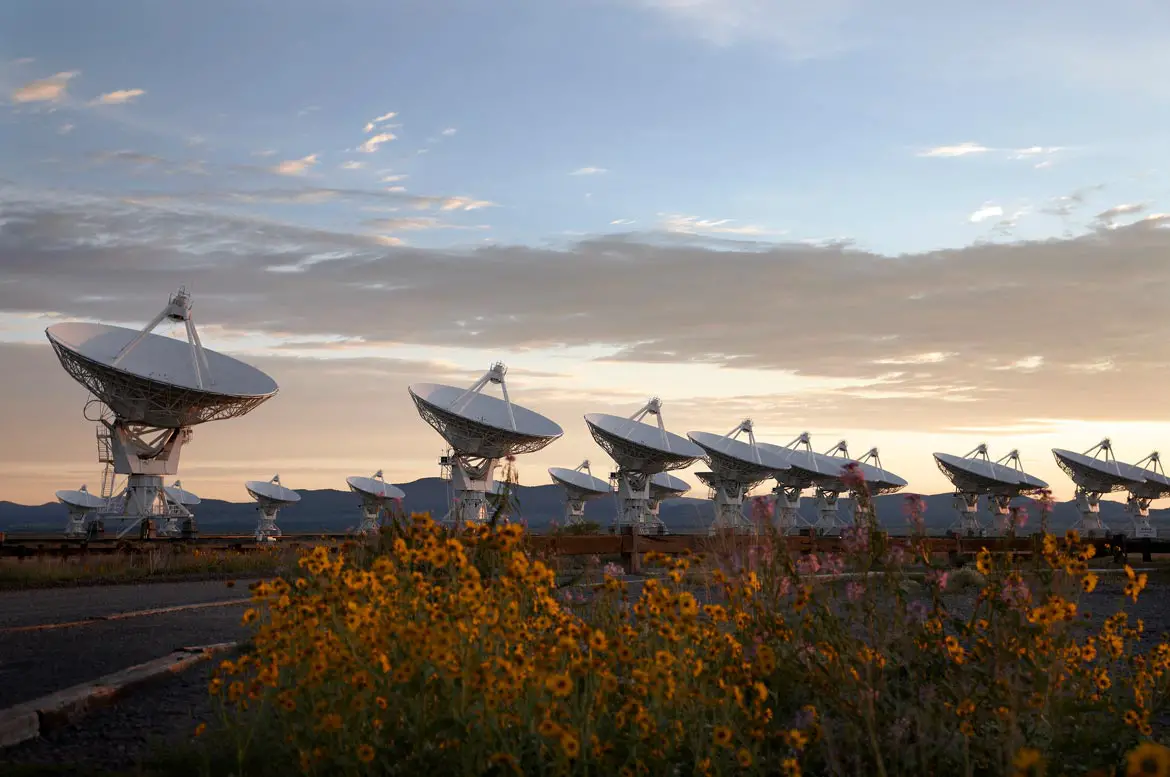
The pulses arrive on Earth like a perfectly timed metronome. The timing is so precise that when Jocelyn Bell measured the first pulsar radio waves in 1967, astronomers thought they might be signals from an alien civilization.
As a gravitational wave passes between us and a pulsar, it throws off the radio wave timing. That’s because, as Albert Einstein predicted, gravitational waves stretch and compress space as they ripple through the cosmos, changing how far the radio waves have to travel.
For 15 years, NANOGrav scientists from the United States and Canada closely timed the radio wave pulses from dozens of millisecond pulsars in our galaxy using the Arecibo Observatory in Puerto Rico, the Green Bank Telescope in West Virginia and the Very Large Array in New Mexico. The new findings are the result of a detailed analysis of an array of 67 pulsars.
“Pulsars are actually very faint radio sources, so we require thousands of hours a year on the world’s largest telescopes to carry out this experiment,” says Maura McLaughlin of West Virginia University, co-director of the NANOGrav Physics Frontiers Center. “These results are made possible through the National Science Foundation’s (NSF’s) continued commitment to these exceptionally sensitive radio observatories.”
Detecting the Background
In 2020, with just over 12 years of data, NANOGrav scientists began to see hints of a signal, an extra “hum” common to the timing behavior of all pulsars in the array. Now, three years of additional observations later, they have accumulated concrete evidence for the existence of the gravitational wave background.
“Now that we have evidence for gravitational waves, the next step is to use our observations to study the sources producing this hum,” says Sarah Vigeland of the University of Wisconsin-Milwaukee, chair of the NANOGrav detection working group.
The likeliest sources of the gravitational wave background are pairs of supermassive black holes caught in a death spiral. Those black holes are truly colossal, containing billions of suns’ worth of mass. Nearly all galaxies, including our own Milky Way, have at least one of the behemoths at their core. When two galaxies merge, their supermassive black holes can meet up and begin orbiting one another. Over time, their orbits tighten as gas and stars pass between the black holes and steal energy.
Eventually, the supermassive black holes get so close that the energy theft stops. Some theoretical studies have argued for decades that the black holes then stall indefinitely when they’re around 1 parsec apart (roughly three light-years). This close-but-no-cigar theory became known as the final parsec problem. In this scenario, only rare groups of three or more supermassive black holes result in mergers.
Supermassive black hole pairs could have a trick up their sleeves, though. They could emit energy as powerful gravitational waves as they orbit one another until eventually they collide in a cataclysmic finale. “Once the two black holes get close enough to be seen by pulsar timing arrays, nothing can stop them from merging within just a few million years,” says Luke Kelley of the University of California, Berkeley, chair of NANOGrav’s astrophysics group.
The existence of the gravitational wave background found by NANOGrav seems to back up this prediction, potentially putting the final parsec problem to rest.
Since supermassive black hole pairs form due to galaxy mergers, the abundance of their gravitational waves will help cosmologists estimate how frequently galaxies have collided throughout the universe’s history. Mingarelli, postdoctoral researcher Deborah C. Good of the CCA and the University of Connecticut, and their colleagues studied the intensity of the gravitational wave background. They estimate that hundreds of thousands or maybe even a million or more supermassive black hole binaries inhabit the universe.
Alternative Sources
Not all the gravitational waves detected by NANOGrav are necessarily from supermassive black hole pairs, though. Other theoretical proposals also predict waves in the ultra-low-frequency range. String theory, for instance, predicts that one-dimensional defects called cosmic strings may have formed in the early universe. These strings could dissipate energy by emitting gravitational waves. Another proposal suggests that the universe didn’t start with the Big Bang but with a Big Bounce as a precursor universe collapsed in on itself before expanding back outward. In such an origin story, gravitational waves from the incident would still be rippling through space-time.
There’s also a chance that pulsars aren’t the perfect gravitational wave detectors scientists think they are, and that they instead might have some unknown variability that’s skewing NANOGrav’s results. “We can’t walk over to the pulsars and turn them on and off again to see if there’s a bug,” Mingarelli says.
The NANOGrav team hopes to explore all the potential contributors to the newfound gravitational wave background as they continue monitoring the pulsars. The group plans to break down the background based on the waves’ frequency and origin in the sky.
An International Effort
Luckily, the NANOGrav team isn’t alone in its quest. Several papers released today by collaborations using telescopes in Europe, India, China and Australia report hints of the same gravitational wave background signal in their data. Through the International Pulsar Timing Array consortium, the individual groups are pooling their data to better characterize the signal and identify its sources.
“Our combined data will be much more powerful,” says Stephen Taylor of Vanderbilt University, who co-led the new research and currently chairs the NANOGrav collaboration. “We’re excited to discover what secrets they will reveal about our universe.”
Reference: “The NANOGrav 15 yr Data Set: Evidence for a Gravitational-wave Background” by Gabriella Agazie, Akash Anumarlapudi, Anne M. Archibald, Zaven Arzoumanian, Paul T. Baker, Bence Bécsy, Laura Blecha, Adam Brazier, Paul R. Brook, Sarah Burke-Spolaor, Rand Burnette, Robin Case, Maria Charisi, Shami Chatterjee, Katerina Chatziioannou, Belinda D. Cheeseboro, Siyuan Chen, Tyler Cohen, James M. Cordes, Neil J. Cornish, Fronefield Crawford, H. Thankful Cromartie, Kathryn Crowter, Curt J. Cutler, Megan E. DeCesar, Dallas DeGan, Paul B. Demorest, Heling Deng, Timothy Dolch, Brendan Drachler, Justin A. Ellis, Elizabeth C. Ferrara, William Fiore, Emmanuel Fonseca, Gabriel E. Freedman, Nate Garver-Daniels, Peter A. Gentile, Kyle A. Gersbach, Joseph Glaser, Deborah C. Good, Kayhan Gültekin, Jeffrey S. Hazboun, Sophie Hourihane, Kristina Islo, Ross J. Jennings, Aaron D. Johnson, Megan L. Jones, Andrew R. Kaiser, David L. Kaplan, Luke Zoltan Kelley, Matthew Kerr, Joey S. Key, Tonia C. Klein, Nima Laal, Michael T. Lam, William G. Lamb, T. Joseph W. Lazio, Natalia Lewandowska, Tyson B. Littenberg, Tingting Liu, Andrea Lommen, Duncan R. Lorimer, Jing Luo, Ryan S. Lynch, Chung-Pei Ma, Dustin R. Madison, Margaret A. Mattson, Alexander McEwen, James W. McKee, Maura A. McLaughlin, Natasha McMann, Bradley W. Meyers, Patrick M. Meyers, Chiara M. F. Mingarelli, Andrea Mitridate, Priyamvada Natarajan, Cherry Ng, David J. Nice, Stella Koch Ocker, Ken D. Olum, Timothy T. Pennucci, Benetge B. P. Perera, Polina Petrov, Nihan S. Pol, Henri A. Radovan, Scott M. Ransom, Paul S. Ray, Joseph D. Romano, Shashwat C. Sardesai, Ann Schmiedekamp, Carl Schmiedekamp, Kai Schmitz, Levi Schult, Brent J. Shapiro-Albert, Xavier Siemens, Joseph Simon, Magdalena S. Siwek, Ingrid H. Stairs, Daniel R. Stinebring, Kevin Stovall, Jerry P. Sun, Abhimanyu Susobhanan, Joseph K. Swiggum, Jacob Taylor, Stephen R. Taylor, Jacob E. Turner, Caner Unal, Michele Vallisneri, Rutger van Haasteren, Sarah J. Vigeland, Haley M. Wahl, Qiaohong Wang, Caitlin A. Witt, Olivia Young and The NANOGrav Collaboration, 29 June 2023, The Astrophysical Journal Letters.
DOI: 10.3847/2041-8213/acdac6

